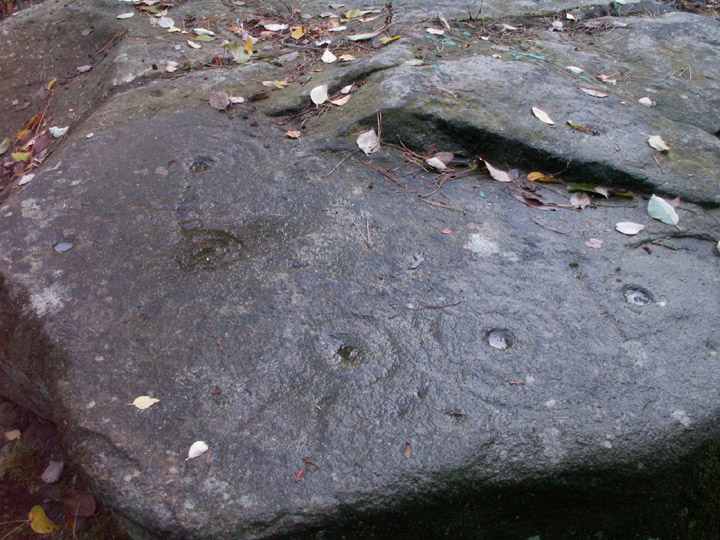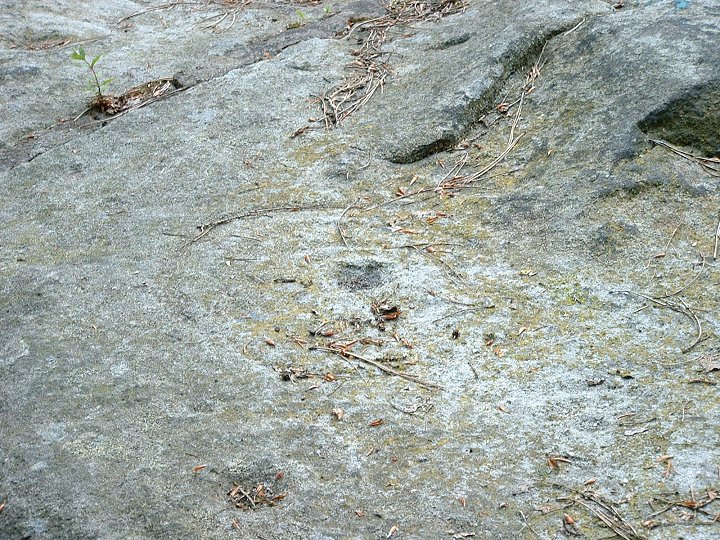
Panorama stone, in its drab setting...

Panorama stone, in its drab setting...

From ‘The Cup and Ring Stones on the Panorama Rocks, near Rombald’s Moor, Ilkley, Yorkshire’ by Nathan Heywood. In ‘Transactions of the Lancashire and Cheshire Antiquarian Society’ v6, 1889.

Which stone is this? I’m confused about Panorama stones completely. How can this be west of the panorama stone but also be the panorama stone... bother.
In the text it talks of three stones in a line about 100yards west of the Panorama stone – and that this is one of them. And it was 10ft by 7ft, at least when properly uncovered. And it sounds like it got moved to behind some railings opposite St. Margaret’s church in Ilkley. Poor Mr Allen reports, it was DEPLORABLY chopped up into several pieces to do so.
From ‘The Cup-and-Ring Sculptures of Ilkley’ by J Romilly Allen, in the Reliquary and Illustrated Archaeologist, 1896.

Title: Ascension 2
Medium: Digital Art
Description: Inspired by the Panorama Stone Prehistoric Rock Carving, Ilkley.

24/11/05

24/11/05

24/11/05

24/11/05

24/11/05
some really nice carvings including the ladder motiff, once you look under all the debris on top of the stones.

24/11/05
after a little work from behind the bars to remove some of the leafs, some rather nice cup and rings appear.

24/11/05
i feel really sorry for the condition of these stones, being kept in this way behind bars.

9/2000

9/2000

9/2000

Taken: 9/2000



The area with the famous cup-and-ring laddered motif. Difficult to see but ladders join the C/Rs on top left, top right and bottom right. Another ladder runs up from the bottom left C/R and terminates at a single line which connects with the top right C/R.

The whole of the stone showing some of the art. The cup-and-ring laddered motif is on the far right.

Panorama Stone

Panorama Stone

Panorama Stone

11/02

The 3 sections of the Panorama stone in their iron prison.

The largest part of the stone.

The 2 smaller sections of the stone.


The Doctor Little Heritage Group is behind a bid to preserve the Panorama Stones, a group of rocks with ancient cup and ring markings, located in Ilkley (England). The group has got the green light to prepare a plan to move them from the overgrown and neglected St Margaret’s Park, Queen’s Road, to the Manor House Museum.
After a meeting with English Heritage, the group wanted to gauge local opinion. At a follow-up open meeting, no voices of dissent were raised against the plan to make replicas of the stones and move them. Parish councillor Brian Mann, the group’s treasurer, said that everyone involved with the project had been astounded to learn that the prehistoric carvings, which could be 5,000 years old, were viewed as one of the most significant European examples of rock art.
The cup and ring markings, made during the Neolithic or Bronze Age, are in serious danger of wearing away from natural erosion. In 1890, Dr Fletcher Little, medical officer at Ben Rhydding Hydro, bought the stones for £10 from the owner of the land at Panorama Rocks where they were situated, because the area was due for development. To preserve them for posterity, he arranged to have them moved to St Margaret’s Park, surrounded by iron railings. While being moved the largest stone, known as the Panorama Stone, broke and had to be repaired.
The plan is to make replicas of the stones to leave in St Margaret’s Park while the actual stones themselves will be transported to a protective enclosure at the Manor House Castle Yard. This would allow the carvings on the replica stones to be recreated in their original glory while preserving what little is left of the originals.
If a grant is awarded the money will go towards research and a feasibility study for the larger project of copying and moving the stones. Coun Mann is confident that the whole project can be completed with the help of the Countryside Agency after officials expressed support for the project in principle. But if the replica stones are not constructed the scheme to move the originals will not be followed through. A less ambitious plan will be substituted to leave the stones where they are with some sort of protective cover constructed to preserve them.
Source: The Ilkley Gazette (19 December 2003)
Ilkley’s a nice enough place, but they found the shittiest little bit of it to put these 3 stones in. Nasty metal fence round them too, I can sorta see why they fence ‘em in to stop graffitti and stuff. But one of the stones had a dirty great green paint splash across it.......same colour as the fence was painted....hmmmm
Just across the road from St. Margaret’s church in Ilkley in an iron fenced enclosure are 3 cup and ring marked rocks know as the Panorama Stone. Originally the stone stood less than a mile away to the west around SE105470 but it was found to be ‘in the way’ of the development of 19th century Ilkley and was cut into 4 pieces, 3 of these being moved to their present positions in 1890 or 1892, depending on which account you read. Where the fourth part went I do not know.
Over the years the carvings on the rocks have badly deteriorated due to weather and vandalism and the marks shown in the web link are not easy to make out, but include cups with between 3 and 5 rings, some with connecting ladder motifs.
Another attempt by Mr Edwards to ‘proof’ the ladder motifs are forged in the online Telegraph & Argus. The article is by Kathie Griffiths:
thetelegraphandargus.co.uk/display.var.1026067.0.stone_age_rock_art_is_fake.php
The message is just the same as in 2004 as posted by Rhiannon.
from This Is Bradford
archive.ilkleygazette.co.uk/2004/7/16/99012.html
Famous markings may be forged?
Internationally renowned prehistoric rock markings may have been forged, it is being claimed. Ilkley’s Panorama Stone is known around the world for its distinctive “ladder” motif.
But far from being the work of our prehistoric ancestors the designs are more likely to have been added by a Victorian workman, according to a local expert. Gavin Edwards, Museums Officer, Archaeology, at the Manor House in Ilkley, stumbled across evidence of possible fraud and skulduggery whilst carrying out research into the Panorama Stones.
And now his findings are set to send shock waves around the archaeological community. But even more surprising, in his view, is the fact that the evidence has been in the public domain for almost a century. Mr Edwards believes Victor-ian illustrations and a report in the Ilkley Gazette in 1913 point to the fact that the ladder design considered to be extremely rare prehistoric artwork -- was added to the original, authentic cup and ring markings.
As evidence he produces two Victorian illustrations, one made by an unknown artist probably in the 1860s, and another which appeared in a publication in 1896. Whist the first shows no evidence of the distinctive, rare design, the latter includes the disputed markings.
He says: “Evidence that the marking on the rock might have been altered in Victorian times is provided by a number of contemporary illustrations. These show significant differences, which might be argued to result from artistic licence or oversight, but a report that appeared in the Ilkley Gazette, March 22, 1913, suggests something much more deliberate.
The report describes a lecture by Mr T C Gill, Bailiff of Ilkley Moor, in which he suggests that some of the markings may have been added. The Bailiff even named the person he believed may have been responsible. One Ambrose Collins, a workman employed at the Semon’s Convalescent Home from 1872-73 was reported to “spend most of his leisure time carving and ornamenting the rocks near the home, evidently hoping that at some future time they would be discovered and become famous.”
Mr Edwards believes his argument is likely to prove controversial as the ladder markings on the Panorama stone are internationally renowned. But he believes the evidence is too powerful simply to ignore.
He said: “The Panorama stones are known internationally be-cause of this unexplained ladder pattern. They are very famous and considered to be very special but I suspect the reason they are special is because they are slightly fraudulent. Once you see the drawings and see the difference, and then read the article you cannot help but come to the conclusion that there is probably something very dodgy about this. Because they are such famous rocks I am deeply surprised that no-one has raised this possibility before. It just seems incredible when the evidence has been there for 90 years. The implication, unfortunately is that if one stone can be altered then how many others have been altered.”
Mr Edwards will be looking at the issue as part of an exhibition at the Manor House later this year. Not Set In Stone looks at rock art today, and will run from September 25 to November 21.
Found this in a booklet about carved rocks -
“In 1890 Dr. Fletcher Little, medical officer at Ben Rhydding Hydro bought the stones for £10 from the owner of the land at Panorama Rocks. The land was due to be developed. Whilst being removed the largest, known as the Panorama Stone was broken in two pieces.”
Panorama Stone on BRAC Updated
A diagram of one of the motifs on the Panorama Stone. Looks to me like a boggle eyed-open mouthed monster riding a push bike. However my theory could be wrong....




































































































































